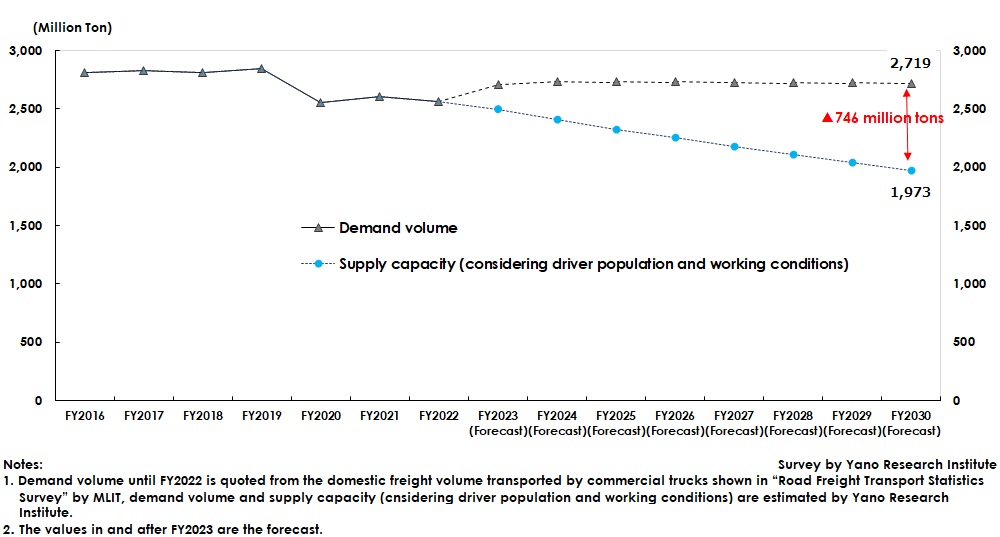No.3517
Logistics Industry for 2030 in Japan: Key Research Findings 2024
Supply-Demand Gap in Freight Transport Volume via Commercial Vehicles for 2030 Forecasted as Annual 746 Million Tons
Yano Research Institute (the President, Takashi Mizukoshi) has surveyed the logistics industry in Japan and has forecasted the domestic freight transport volume and the domestic warehousing area under jurisdiction for 2030. Here discloses the gap between supply and demand in freight transport volume via commercial freight vehicles for FY2030.

Summary of Research Findings
According to “Road Freight Transport Statistics Survey” by Ministry of Land, Infrastructure, Transport and Tourism (MLIT), freight transport volume in Japan for FY2022 was 2,558 million tons. Based on this figure, demand volume (total freight volume) and weight-based supply capacity were calculated in this research by estimating the number of drivers and their labor conditions for FY2030.
The difference between the above-mentioned demand volume and supply capacity for FY2030 was 746 million tons per year and 62 million tons per month. These figures were the supply-demand gap in freight transport volume via commercial vehicles for FY2030 if no effective measures were taken. This indicated that 11.5 day-volume of freight a month was forecasted as beyond the capacity.
First, demand volume, or freight transport volume, was forecasted by taking account future population and GDP forecast added to the rate of change between FY2010 and FY2019 road freight transport volume by commercial vehicles. FY2030 domestic freight transport volume by commercial vehicles was estimated as 2,719 million tons.
With the domestic freight transport volume via commercial vehicles was in the declining trend, freight transport volume forecast for FY2030 was 106.3% of that of FY2022, and 95.7% of FY2019 when there had been no pandemic impacts.
Next, supply capacity forecast used the calculations of truckdriver population and working hours for FY2030.
Truckdriver population was estimated based on the number of workers dedicated to vehicle driving in road freight carriers shown in “A National Census” by Statistic Bureau, Ministry of Internal Affairs and Communications (MIC), which led to the estimation of 590 thousand truckdrivers in 2030. This was 75.7% of 2020, and 60.6% of 2000, a significant decline.
Truckdriver working hours were estimated by referring to working hours in road freight industry shown in “Basic Survey on Wage Structure” by Ministry of Health, Labour and Welfare (MHLW), at and found out to be 2,447 hours for FY2030.
If no effective measures were taken by FY2030, the supply capacity for FY2030 was to be 1,973 million tons, when calculating FY2022 freight transport volume per driver per hour multiplied by FY2030 truckdriver population and labor hour forecast values. The difference between demand volume and supply capacity for FY2030 was 746 million tons, the supply-demand gap mentioned above.
Noteworthy Topics
Powerful Driving Force Needed to Improve Truck Load Efficiency, and Fundamental Solution Requires Beneficial Remuneration for Truckdrivers
The following measures may be effective to solve the supply-demand gap in freight transport volume via commercial vehicles for FY2030: 1) Improvement in truck load efficiency, 2) modal shift (use of vessels or railways), 3) reduction of cargo handling/waiting hours.
Regarding improvement of truck load efficiency, “Comprehensive Physical Distribution Policy (FY2021-FY2025)” by MLIT mentions that it aims to raise the target indicator of truck load efficiency from 37.7% (FY2019) to 50.0% (FY2025). Nevertheless, the freight load efficiency of commercial vehicles for FY2022 remained at 40.12%, according to the annual report of the “Road Freight Transport Statistics Survey”.
The target of 50% for truck load efficiency, therefore, is quite challenging, and requires strong driving force to achieve. To practically attain the target, load efficiency improvement should be addressed more in detail, such as increasing the rate of distance loaded as well as the percentage of actual working time, while taking other measures such as promotions of modal shift and reduction of cargo handling & waiting hours.
In addition, to solve the fundamental issue, improvement in truckdriver working conditions and wages is indispensable, in parallel with the above-mentioned measures.
Research Outline
2.Research Object: Domestic logistics businesses (transport businesses, warehousing businesses, logistics robot manufacturers, logistic-tech companies, etc.)
3.Research Methogology: Face-to-face interviews by expert researchers (including online), indirect interviews via telephone or email, and literature research
Supply-Demand Gap in Freight Transport via Commercial Vehicles
Supply-demand gap in freight transport volume via commercial vehicles was estimated by forecasting demand volume (total freight volume) and supply capacity.
Demand volume: Estimated based on the domestic freight volume transported by commercial trucks shown in “Road Freight Transport Statistics Survey” by Ministry of Land, Infrastructure, Transport and Tourism (MLIT)
Supply capacity: Estimated the truckdriver population based on the number of workers dedicated to vehicle driving in road freight carriers shown in “A National Census” by Statistic Bureau, Ministry of Internal Affairs and Communications (MIC), and estimated the truckdriver working hours by referring to working hours in road freight industry shown in “Basic Survey on Wage Structure” by Ministry of Health, Labour and Welfare (MHLW).
<Products and Services in the Market>
Freight transport volume via commercial vehicles in Japan, Class 1 to Class 3 free warehouses
Published Report
Contact Us
The copyright and all other rights pertaining to this report belong to Yano Research Institute.
Please contact our PR team when quoting the report contents for the purpose other than media coverage.
Depending on the purpose of using our report, we may ask you to present your sentences for confirmation beforehand.